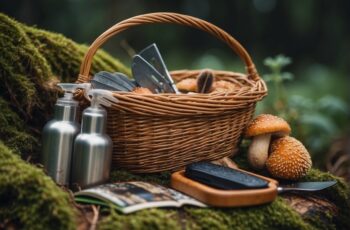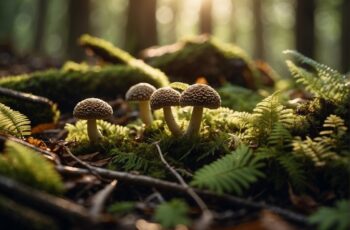Mushroom hunting is an activity that connects you with nature and provides the thrill of discovering edible treasures hidden within the woods. To embark on this journey, it’s crucial to recognize and understand the environments where mushrooms flourish. Just like any other form of foraging, finding mushrooms requires a blend of knowledge and observational skills. It’s not just about wandering through the forest; it’s about reading the subtle cues of the landscape and the patterns of growth that mushrooms follow.
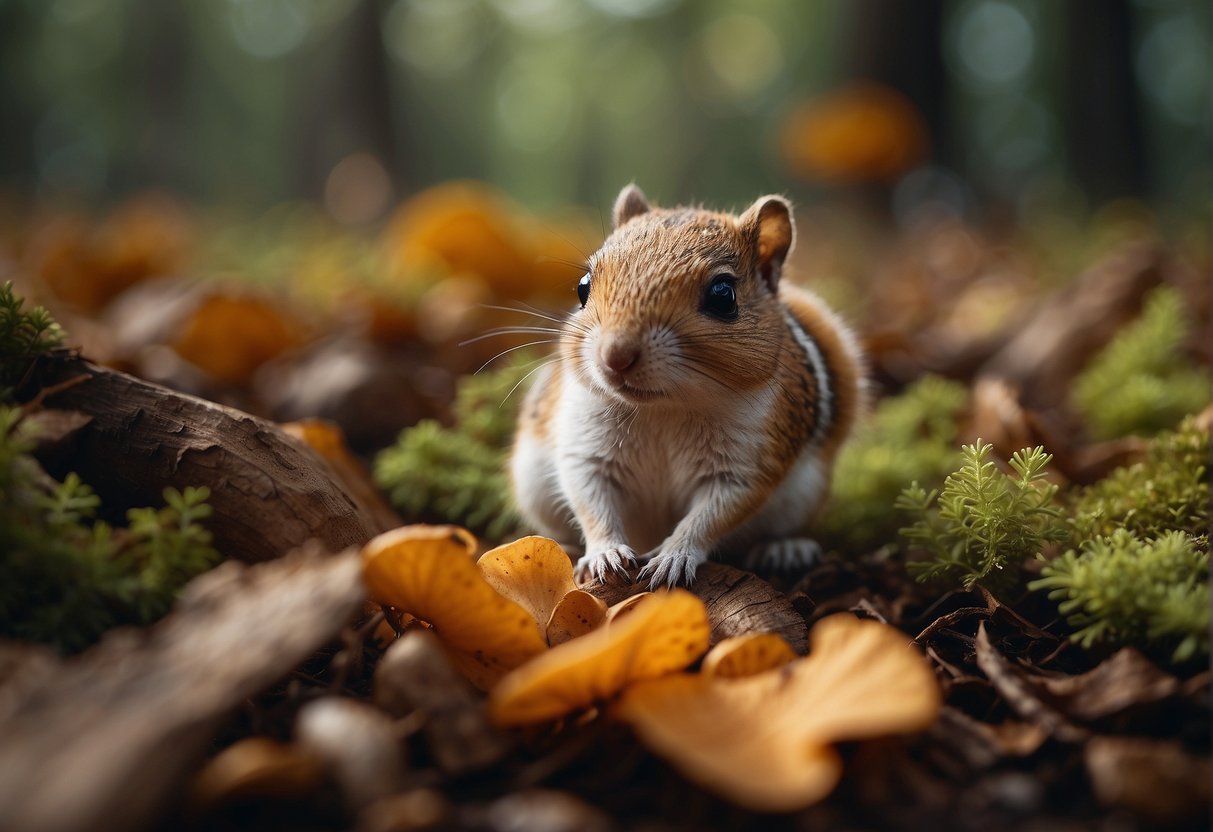
Equipped with the expertise on morel mushrooms, which are prized by mushroom hunters for their flavor and elusiveness, you can time your forays to coincide with the peak seasons in your area. Furthermore, knowing how to accurately identify mushrooms is essential to ensure a safe and rewarding experience. The practice involves differentiating the edible species from the toxic ones, as well as understanding how the weather, terrain, and other plants correlate with mushroom emergence. Above all, it involves a deep respect for the woodland ecosystems and the role that fungi play in them.
Key Takeaways
- Familiarize yourself with mushroom habitats to increase your chances of a successful forage.
- Knowledge of mushroom varieties and identification techniques is crucial for safe foraging.
- Respect for the environment enhances the experience of mushroom hunting.
Understanding Mushroom Habitats
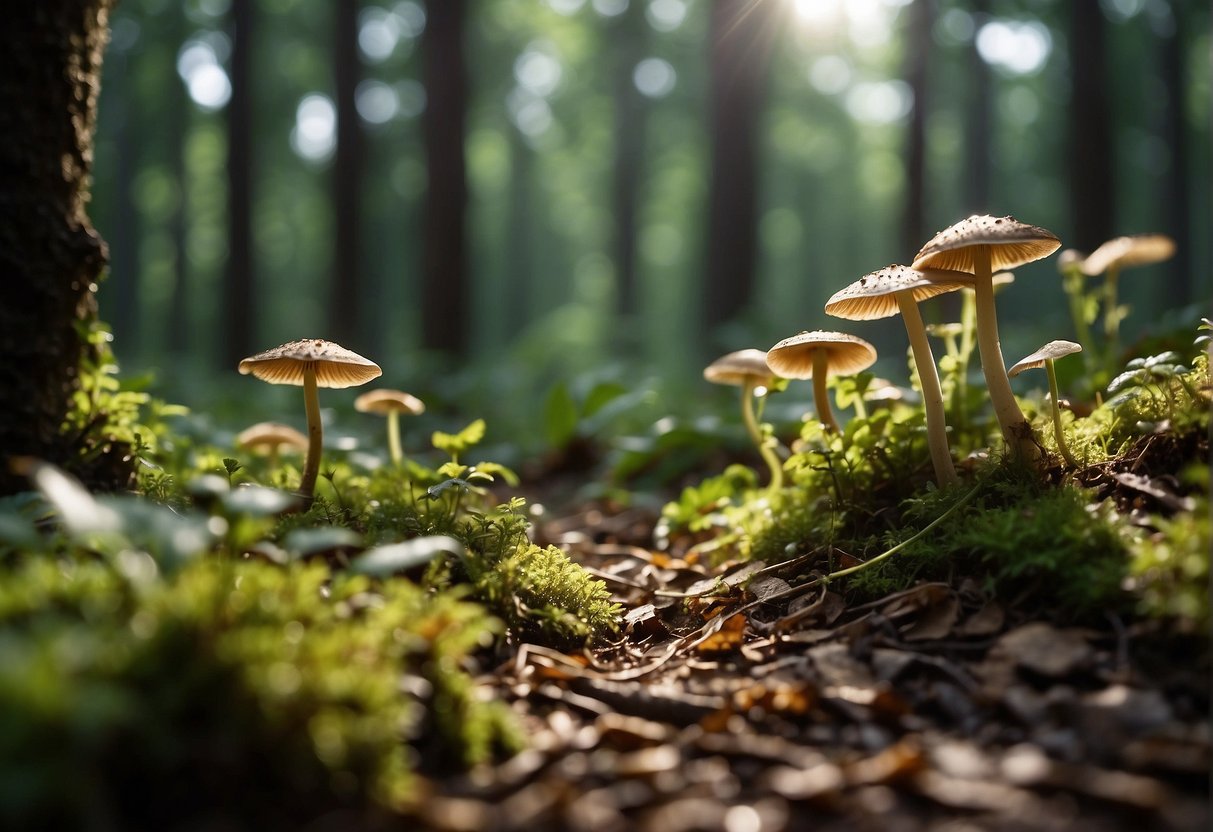
Exploring mushroom habitats is crucial to successful foraging; recognizing where mushrooms thrive can lead to fruitful harvests. Different species favor diverse conditions—ranging from nutrient-rich soils to specific tree associations.
Recognizing Fertile Soils
Soil is the foundation of life for many mushrooms. You’re more likely to find mushrooms flourishing in soils rich in organic matter. Pay close attention to river bottoms and burn areas, as mushrooms often appear in these regions where the soil has been recently enriched.
Forest and Tree Associations
In forests, certain trees such as ash, elm, and sycamore create environments conducive to mushroom growth. Mushroom species tend to form symbiotic relationships with specific trees. For instance, morels are particularly fond of forests where elm trees have recently died, often appearing in the following season.
Identifying Key Environments
Mushrooms aren’t just restricted to dense forests; they can be found in a variety of habitats. When exploring your local environment, consider places like grasslands and even urban areas. However, keep in mind that a habitat’s moisture, temperature, and the presence of decaying organic matter play key roles in where mushrooms decide to establish themselves.
The Science of Morels
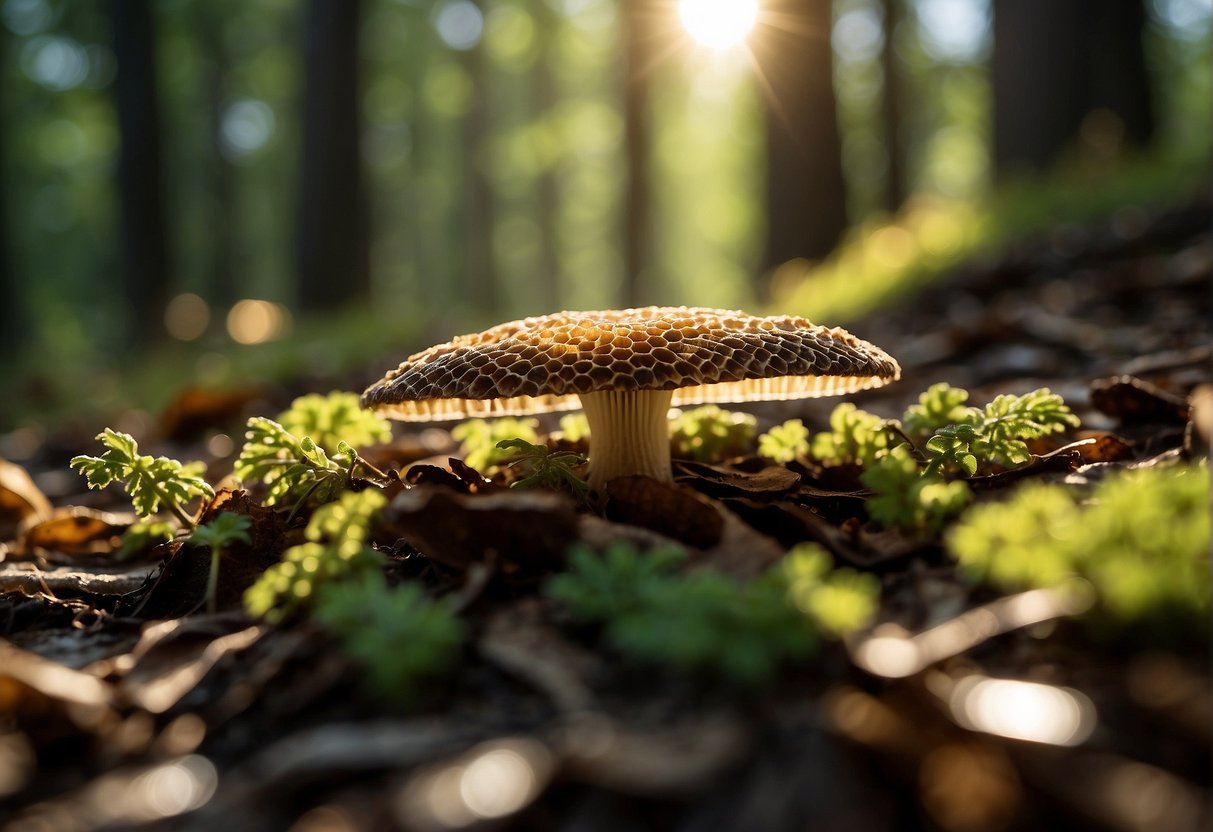
When hunting for the elusive morel mushrooms, understanding their life cycle and the environmental conditions they favor can significantly increase your chances of success. Learn the science behind these prized fungi to enhance your foraging adventures.
Morel Mushroom Life Cycle
Morels, like all fungi, begin their life as spores. These microscopic entities require moist soil to germinate into a network known as mycelium. This vast, web-like structure remains underground, unseen until just the right conditions trigger the production of fruiting bodies—those unique, honeycomb-capped mushrooms you’re after.
Key Stages:
- Spore release: Typically after a rainy spring day
- Mycelial growth: Occurs underground during warmer temperatures
- Fruiting: When conditions are favorable, often in spring, morels send up their fruiting bodies
Environmental Conditions Favoring Morels
To maximize your foraging yield, pay attention to the weather. Morels thrive when the soil temperature is around 50 degrees. The combination of warmth from the spring sun and wet conditions from seasonal rains creates a hospitable environment for these fungi. Morels favor high humidity, which is why you’ll often find them in forested areas where the moisture is retained.
Ideal Conditions:
- Temperature: Soil warmed to near 50 degrees Fahrenheit
- Moisture: Adequate rainfall to maintain soil humidity
- Habitat: Deciduous woods and areas recovering from forest fires
By aligning your morel hunting with these scientific insights, you’ll be scanning the forest floor with a knowledgeable eye. Remember, patience and perseverance go hand in hand with the science of morel foraging.
Mushroom Identification Techniques
In the quest for foraging mushrooms, precise skills in identifying species are essential. You’ll want to distinguish between the benign and the hazardous, using both visual cues and reliable resources to guide your search.
Visual Identification Tips
Cap Characteristics: Observe the shape, size, and color of the mushroom cap. For example, Chanterelle mushrooms display a distinctive funnel shape, whereas Russula species have a more flat and broad appearance.
Stem and Gills: Examine the stem (stipe) and the gills beneath the cap. Cut the stem to inspect its interior for any unusual color changes. The stem of an Armillaria, or honey fungus, will often feature a ring or skirt. Additionally, note the gill structure; Boletes do not have traditional gills but exhibit pores.
Spore Print: Create a spore print by placing the mushroom cap gill-side down on paper. Different species will leave spore prints of various colors, aiding in accurate identification.
Toxic Lookalikes: Always be aware of toxic species such as Amanita, which can look akin to edible varieties. For instance, false morels may resemble the edible Morchella, but consuming them can be dangerous.
Using Field Guides and Resources
Field Guides: Carry a field guide on edible wild mushrooms to cross-reference visual observations with documented characteristics.
Online Resources: Utilize online databases and communities specializing in mycology, which often provide extensive information on mushroom genus, species, and identifying features.
Practical Mushroom Foraging Tips
Embarking on mushroom foraging can be a rewarding hobby. Following the right tips and techniques is essential for a fruitful hunt. Here, we’ll discuss the best times to forage, necessary equipment, and how to forage ethically.
When to Forage for Mushrooms
The prime mushroom season varies by region, but generally, the best time for foraging is during the moist and mild periods of late spring through fall. In the Midwest and Northeast, for example, June can be a particularly good month, as the weather conditions help mushrooms thrive.
- Timing: Early morning can be ideal because mushrooms are less likely to be disturbed by other foragers or wildlife.
- Climate: After a rainstorm when the weather starts to warm up is prime time for mushrooms to emerge.
Equipment and Safety Measures
When heading into the woods, certain equipment is key for a successful mushroom hunter.
- Identification Guide: Carry a regional mushroom guidebook or app for quick reference.
- Knife: A sharp knife is essential for harvesting mushrooms without damaging the mycelium.
- Basket or Mesh Bag: Helps in carrying your finds and spores can disperse through the mesh, promoting future growth.
Safety Measures:
- Bright Clothing: Wear bright clothes so you’re easily seen by others, especially during hunting season.
- GPS or Compass: Always know how to navigate your way back to avoid getting lost.
- Know Your Mushrooms: Don’t eat anything unless you’re 100% sure of its identification. When in doubt, leave it out.
Ethical Foraging Practices
Respect the habitat and maintain ethical foraging practices to support the ecosystem and future growth.
- Harvesting: Cut or gently twist mushrooms instead of pulling them to preserve the underlying mycelium.
- Limits: Only take what you plan to eat to avoid waste and to leave some for wildlife and other foragers.
- Disposal: Leave any questionable mushrooms where you found them. Do not introduce them to a different area as this could disrupt local ecology.
Preserving and Preparing Mushrooms
When you’ve hit the jackpot in the wild and your basket is brimming with morels, understanding the best practices for preserving and preparing these elusive fungi is paramount. Proper cleaning and storage techniques can significantly prolong their shelf life, while knowing how to cook various mushroom varieties enhances their natural flavors and ensures safe consumption.
Cleaning and Storing Morels
Morel mushrooms are like sponges; they readily absorb water, which can lead to a soggy texture if you’re not careful. To clean morels without soaking them, use a soft brush to gently remove dirt and debris. After brushing, cut the morels in half to check for insects and rinse them quickly under cold running water to wash away any remaining soil. Salting the water may help to drive out any insects residing within the hollows of the mushrooms.
Once cleaned, pat the morels dry with paper towels. If you’re not going to use them immediately, spread your morels on a baking sheet and freeze them individually before transferring them to a sealed container or freezer bag. This method helps to maintain their size and structure, preventing them from becoming clumped together.
Cooking Guidelines for Mushroom Varieties
Each mushroom variety has its unique flavor profile and textural nuances, and cooking them properly brings out their best. Morels, for example, shouldn’t be eaten raw due to potential bacteria. They shine when sautéed, giving a deliciously earthy taste to your dishes. You can also batter and fry them for a crispy treat. The key is to cook them thoroughly but gently.
For morels and other edible mushrooms, consider the following:
- Size: Cut larger mushrooms into consistent sizes for even cooking.
- Heat: Use medium to high heat to evaporate moisture quickly, thus browning the mushrooms and concentrating their flavor.
- Don’t overcrowd: Give your mushrooms plenty of space in the pan to ensure they sauté rather than steam.
Remember, patience during preparation pays off with the ultimate reward of a tasty, perfectly cooked mushroom dish.
Advancing Your Mycological Knowledge
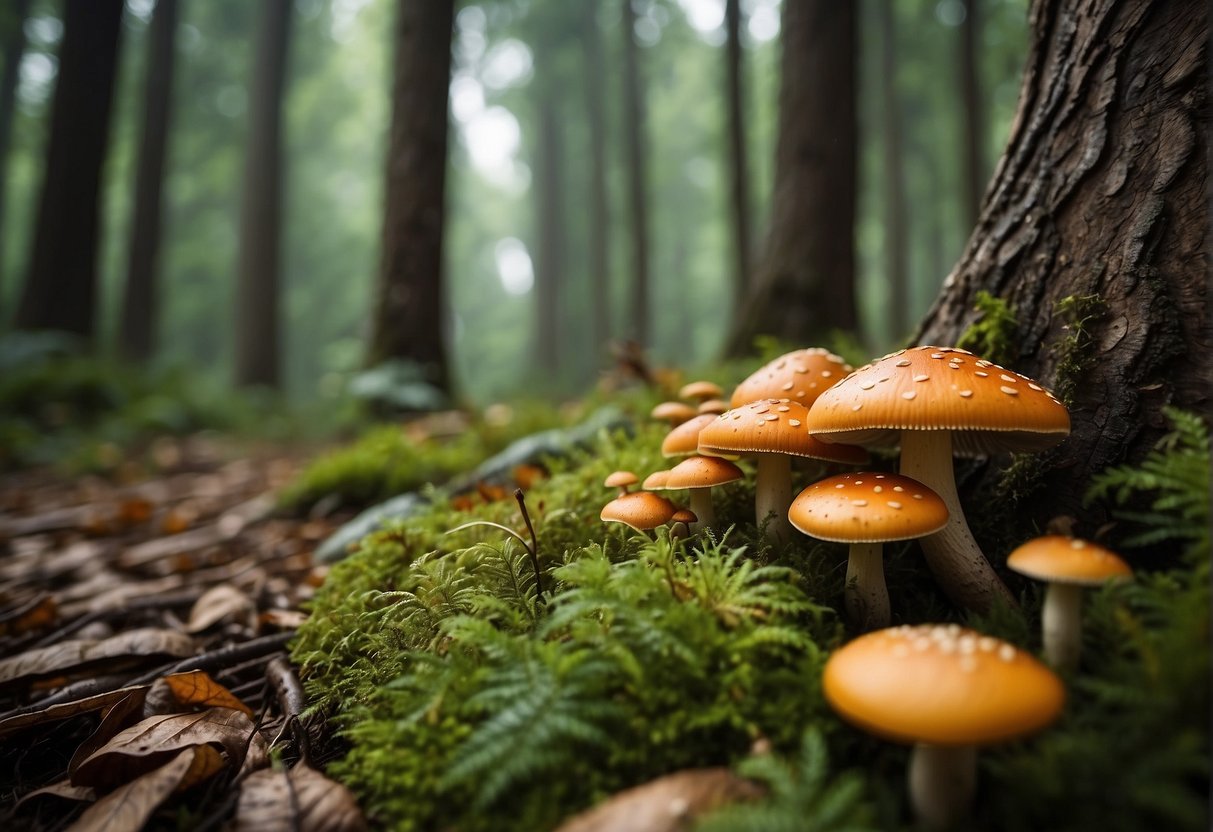
To truly appreciate the vast world of fungi, it’s essential to deepen your understanding of mycology and the diverse habitats that fungi occupy. Let’s explore how you can enhance your expertise and enjoyment of mushroom hunting.
Mycology for Enthusiasts
Mycology, the study of fungi, is more than just a pastime—it’s a way to connect with nature’s intricate ecosystems. As you begin your journey, familiarizing yourself with fungal ecology will give you insights into how mushrooms and their environments interact. Start by learning the basics:
- Spores: the seeds of the fungal world, vital for reproduction.
- Habitats: from woodlands to grassy plains, each provides a unique niche for certain fungi.
For example, morel mushroom hunting is not just about finding these elusive fungi; it’s about understanding their affinity for recently burnt woodland or elm tree populations. Recognizing these patterns makes you more than just a mushroom hunter; you become a steward of the land.
Beyond Morels: Expanding your Mushroom Knowledge
Once you’ve got the hang of morels, widen your scope to other fascinating species like oysters and chicken of the woods. These species are not only great for foraging but are also indicators of forest health. As you advance:
- Seek out different species such as the turkey tail, known for its unique fan-shaped appearance.
- Participate in local foraging groups to exchange knowledge with fellow enthusiasts.
Mushroom hunting can take you from the familiar comfort of oyster mushrooms growing on the side of trees to the striking, shelf-like formations of chicken of the woods. Each mushroom you encounter tells a story about the soil, the season, and the surrounding flora. By recognizing these details, you transform into a more informed and respectful harvester, one who takes only what is needed and leaves the ecosystem intact for future generations.

